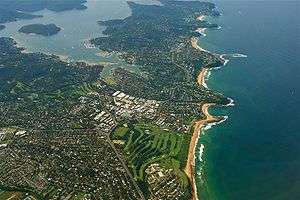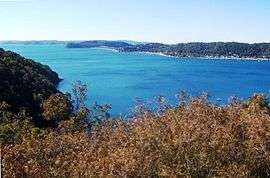Pittwater
| Pittwater | |
| Semi–mature tide dominated, drowned valley estuary[1] | |
 Aerial view of a part of Sydney's Northern Beaches, with Pittwater and Scotland Island on the left. | |
| Named for: William Pitt the Younger[2] | |
| Country | Australia |
|---|---|
| State | New South Wales |
| Region | Greater Metropolitan Sydney |
| Municipality | Northern Beaches Council |
| Part of | Hawkesbury–Nepean |
| Tributaries | |
| - left | Bilgola Creek |
| - right | McMahon's Creek, Careel Creek |
| Primary source | McCarrs Creek |
| - location | west of Church Point |
| - coordinates | 33°38′38.3994″S 151°16′55.2″E / 33.643999833°S 151.282000°E |
| Secondary source | Cahill Creek |
| - location | Mona Vale |
| - coordinates | 33°39′59.3994″S 151°18′41.3994″E / 33.666499833°S 151.311499833°E |
| Mouth | Broken Bay |
| - location | West Head and Barrenjoey Head |
| - coordinates | 33°34′47.9994″S 151°18′57.6″E / 33.579999833°S 151.316000°ECoordinates: 33°34′47.9994″S 151°18′57.6″E / 33.579999833°S 151.316000°E |
| Length | 10 km (6 mi) |
| Width | 1 km (1 mi) |
| Depth | 9.9 m (32 ft) |
| Volume | 181,836.2 m3 (6,421,485 cu ft) |
| Basin | 50.8 km2 (20 sq mi) |
| Area | 18.4 km2 (7 sq mi) |
| Island | Scotland Island |
| Website: NSW Environment and Heritage webpage | |
Pittwater is a semi–mature tide dominated drowned valley estuary,[1] located about 40 kilometres (25 mi) north of the Sydney central business district, New South Wales, Australia; being one of the bodies of water that separate greater Metropolitan Sydney from the Central Coast.
Pittwater has its origin from the confluence of McCarrs Creek, to the west of Church Point and a number of smaller estuaries, the largest of which is Cahill Creek, that joins the Pittwater north of Mona Vale. The Pittwater is an open body of water, often considered a bay or harbour, that flows north towards its mouth into Broken Bay, between West Head and Barrenjoey Head, less than 1 kilometre (0.62 mi) from the Tasman Sea.
The total area of the Pittwater is 18.4 square kilometres (7.1 sq mi) and around ninety percent of the area is generally administered by the Hawkesbury–Nepean Catchment Management Authority, in conjunction with Northern Beaches Council.
The land adjacent to the Pittwater was occupied for many thousands of years by the Kuringgai Aboriginal peoples. They used the river as an important source of food and a place for trade.[3]
Pittwater was named Pitt Water in 1788 in honour of William Pitt the Younger, then Prime Minister of Great Britain.[2]
Geography
Pittwater extends from Mona Vale and Warriewood in the south, along the eastern ridge of the Barrenjoey Peninsula leading to Palm Beach and along the western ridge of the Lambert Peninsula leading to West Head. The eastern parts of the catchment are largely urbanised whilst the western parts are primarily Ku-ring-gai Chase National Park.[3] Within the Pittwater lies Careel Bay, Refuge Cove, Saltpon Cove, Horseshoe Cove, Crystal Bay, McCarrs Creek, Browns Bay, Elvina Bay, Lovett Bay, Towlers Bay, Portuguese Bay, Coasters Retreat and The Basin.[2] Scotland Island is located within the estuary.
Pittwater contains a diversity of estuarine habitat types including mangrove wetlands, saltmarsh, sand flats and seagrass meadows,[3] including threatened areas of coastal saltmarsh.[4]
History
Aboriginal history
The Kuringgai, often called Guringai, peoples were the traditional inhabitants of the land and waterways north of Sydney Harbour, through the Lane Cove River and across Broken Bay and beyond to Brisbane Water. Amongst the Kuringgai, there were many smaller units called clans, of which the Carigal were most prominent in the area surrounding Pittwater.[5] During 1789 the impact of smallpox on aboriginal peoples led to extensive mortality, with the death rate estimated at somewhere between 50% and 90%. Conservatively, between 500 and 1000 Aboriginal people died on the coastal strip bounded by Botany Bay and Broken Bay. A significant proportion of these were Kuringgai.[6]
European history
The waterway was surveyed by crew members of HMS Sirius in 1788, and named Pitt Water after William Pitt the Younger, then Prime Minister of Great Britain. Pitt Water was said to be the first place in Australia to be formally named.[2][7] The first regular water transport across Pittwater was the cutter Francis which carried settlers and farm produce from Sydney between 1793 and 1800.[8] By 1803 a fleet of privately owned coasters had begun operating between Pittwater, Cowan Creek and Berowra Waters, usually travelling in convey to reduce the risk of piracy by escaped convicts living along the shore. These vessels were generally built on Scotland Island and were not sufficiently seaworthy to leave Broken Bay. A customs house operated from Pittwater between 1843 and 1900, and a government-built sandstone lighthouse was completed at Barrenjoey in 1881.[8] Both the Old Customs House and the lighthouse are listed on the Register of the National Estate.[9][10]
Shipping declined as a transport medium following road and rail construction through the region between 1850 and 1890, especially the construction of a rail bridge over the waterway in 1899. The last locally constructed shipping vessel was launched from a shipyard at Blackwall in 1912, and scheduled shipping services ceased in 1914.[8] However, since the 1950s, Pittwater has become predominantly residential in character and is a suburban region of Sydney.[11] The greater Sydney metropolis has extended to Palm Beach, Church Point and offshore communities in Pittwater, however its early character has been largely retained.[7]
Current use and activities

Today, the Pitwater is a popular water recreation, such as sailing and fishing. The area is an important natural heritage area that comprises wetlands, bushland, lagoons, a waterway, rock platforms and beaches.[12]
The Pittwater to Coffs Harbour Yacht Race is held in January annually, and has been since 1981.[13]
The area gives its name to:
- The former Pittwater Council
- The Electoral district of Pittwater
- Pittwater High School
- Pittwater Park
- Little Pittwater Bay, in Hornsby Shire
Churches
Presbyterian
- The Pittwater Presbyterian Church has been ministering to the people of Pittwater and the surrounding suburbs since 1956.[14] The current ministry coordinator is Rob Lamont, who succeeded Phil Rawlings in June 2014, after 23 years of ministry.[15] The church is located on the corner of Robertson Road and Foamcrest Ave, in Newport and meets at 9am and 7pm every Sunday
Rob Lamont is also the Chaplain at Pittwater High School and Newport Surf Life Saving Club. The Church also runs a once a month Prayer service on a Friday Night
Anglican
- The Newport Anglican Church meets right next to the Pittwater Post Office at 9.30am on Sundays. The Senior Minister is Rev. Jason Ramsay, since 2007.
See also
References
- 1 2 Roy, P. S; Williams, R. J; Jones, A. R; Yassini, I; et al. (2001). "Structure and Function of South-east Australian Estuaries". Estuarine, Coastal and Shelf Science. 53: 351–384. doi:10.1006/ecss.2001.0796.
- 1 2 3 4 "Pittwater". Geographical Names Register (GNR) of NSW. Geographical Names Board of New South Wales. Retrieved 7 August 2013.
- 1 2 3 WBM Oceanics Australia (May 2006). "Pittwater Estuary: Management Study" (PDF). Pittwater Council. Retrieved 1 January 2012.
- ↑ "Coastal Saltmarsh". Environment: Threatened Species, Populations and Communities. Pittwater Council. 16 November 2012. Retrieved 1 January 2013.
- ↑ "Ku-ring-gai Chase National Park: Aboriginal heritage". NSW National Parks & Wildlife Service. Office of Environment and Heritage. Retrieved 1 January 2013.
- ↑ Kohen, James (2012). "The Ku-Ring-Gai Tribe". Focus on Ku-ring-gai. Ku-ring-gai Historical Society Inc. Retrieved 1 January 2013.
- 1 2 "The History of Pittwater Peninsula". Australian Travel & Tourism Network Pty Limited.
- 1 2 3 Clark, Mary (August 2001). Ships, Shores and Trading Ports. Waterways Authority of NSW. pp. 107–108. ISBN 0-7313-8898-4.
- ↑ "Site of the Old Customs House, Barrenjoey Rd, Palm Beach, NSW, Australia". Australian Heritage Database. Commonwealth of Australia: Department of Sustainability, Environment, Water, Population and Communities. 1 November 1983. Retrieved 22 September 2012.
- ↑ "Barrenjoey Lighthouse Group, Beach Rd, Palm Beach, NSW, Australia". Australian Heritage Database. Commonwealth of Australia: Department of Sustainability, Environment, Water, Population and Communities. 21 October 1980. Retrieved 22 September 2012.
- ↑ "History & Heritage: Overview". Pittwater Council. Retrieved 22 September 2012.
- ↑ "Pittwater Natural Resources". Pittwater. Holiday Oz. 2007. Retrieved 22 September 2012.
- ↑ "Race Results". 2013 Pittwater & Coffs Harbour Regatta. The Royal Prince Alfred Yacht Club. Retrieved 25 January 2014.
- ↑ Grant, Robert; Dixon, Jean. The history of the Presbyterian Church Pittwater Parish (1956-1989).
- ↑ Pittwater Presbyterian Church. 2014 http://www.pittwater.org/. Missing or empty
|title=(help)
External links
| Wikimedia Commons has media related to Pittwater. |
- Cowan Creek / Pittwater Subcatchment at the Hawkesbury–Nepean Catchment Management Authority website
- Pittwater Natural Heritage Association website
- Pittwater online news website
- Map of Pittwater's Creeks and Wetlands from Pittwater Council
- local church website